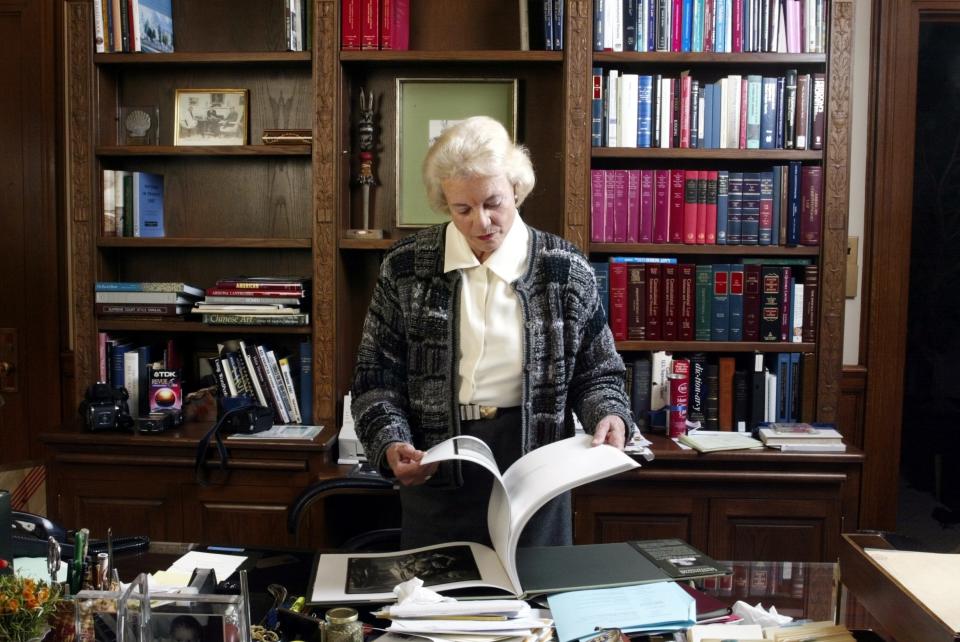Retired Supreme Court Justice Sandra Day O'Connor, first woman to serve on the high court, dies
- Oops!Something went wrong.Please try again later.
WASHINGTON – Retired Supreme Court Justice Sandra Day O’Connor, the first woman to serve on the nation's highest court and a crucial swing vote during her twenty-five year tenure, died on Friday. She was 93.
A key figure in landmark Supreme Court cases dealing with abortion, affirmative action and civil rights, O’Connor retired from the high court in 2006 and announced in 2018 that she had been diagnosed with dementia and would withdraw from public life.
O’Connor was President Ronald Reagan’s first nominee to the Supreme Court, joining the court in 1981 after an already notable career that included serving as the majority leader in Arizona’s state Senate – the first woman to hold that title in the nation.
She died of complications related to advanced dementia, probably Alzheimer’s, and a respiratory illness, according to a statement from the Supreme Court.
"A daughter of the American Southwest, Sandra Day O’Connor blazed an historic trail as our nation’s first female justice," Chief Justice John Roberts said in a statement. "She met that challenge with undaunted determination, indisputable ability, and engaging candor. We at the Supreme Court mourn the loss of a beloved colleague, a fiercely independent defender of the rule of law, and an eloquent advocate for civics education. And we celebrate her enduring legacy as a true public servant and patriot."
During much of her time on the court, which spanned three chief justices, O'Connor was a swing vote in many blockbuster cases. She helped craft a 1992 opinion in Planned Parenthood v. Casey that upheld a woman's right to an abortion but permitted states to impose additional restrictions. That decision, along with the court's 1973 ruling in Roe v. Wade, was overruled by the court's conservative majority in June.
More:Retired Justice Sandra Day O'Connor announces dementia diagnosis
O'Connor wrote for the majority in Grutter v. Bollinger, a 2003 decision that permitted universities to consider race as a factor in admissions to boost minority enrollment as long as they also weighed other characteristics unique to individual applicants. That precedent was abandoned last term when the Supreme Court struck down affirmative action policies at Harvard University and the University of North Carolina.

O’Connor joined the court's 5-4 ruling that decided the 2000 presidentialelection in favor of George W. Bush. She later questioned whether the court should have gotten involved, telling the Chicago Tribune that it "stirred up the public" and "gave the court a less-than perfect reputation."
Born in Texas, O’Connor grew up on a cattle ranch in rural Arizona, where she developed a skepticism of the federal government's land management policies – a perception some observers say influenced her commitment to federalism and state rights on the court. She graduated high school at 16 and enrolled at Stanford University, where she later continued on to study law.
O'Connor announced her retirement – earlier than some expected – to care for her husband, who had advanced Alzheimer's and who died in 2009. She was succeeded by Samuel Alito, who is now the second-most senior associate justice on the Supreme Court.
After an active post-court career – including serving as chancellor of the College of William & Mary in Virginia –O’Connor largely remained out of public view after announcing her dementia diagnosis in 2018.
"While the final chapter of my life with dementia may be trying, nothing has diminished my gratitude and deep appreciation for the countless blessings in my life," she wrote in a letter released by the court at the time.
"How fortunate I feel to be an American and to have been presented with the remarkable opportunities available to the citizens of our country," she added. “As a young cowgirl from the Arizona desert, I never could have imagined that one day I would become the first woman justice on the U.S. Supreme Court."
This article originally appeared on Louisville Courier Journal: Sandra Day O'Connor, first woman to serve on the Supreme Court, dies

